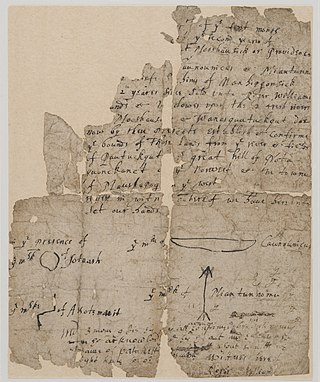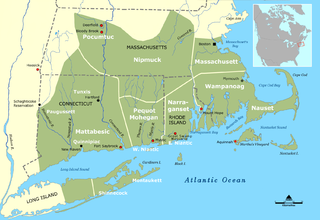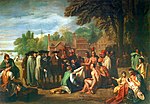The Nonintercourse Act is the collective name given to six statutes passed by the United States Congress in 1790, 1793, 1796, 1799, 1802, and 1834 to set boundaries of American Indian reservations. The various acts were also intended to regulate commerce between White Americans and citizens of Indigenous nations. The most notable provisions of the act regulate the inalienability of aboriginal title in the United States, a continuing source of litigation for almost 200 years. The prohibition on purchases of Indian lands without the approval of the federal government has its origins in the Royal Proclamation of 1763 and the Confederation Congress Proclamation of 1783.

The Walking Purchase, also known as the Walking Treaty, was a 1737 agreement between the family of William Penn, the original proprietor of the Province of Pennsylvania, and the Lenape native Indians. In the purchase, the Penn family and proprietors produced a deed to claim that a 1686 treaty with the Lenape ceded an area of 1,200,000 acres (4,860 km2) in present-day Lehigh Valley and Northeastern Pennsylvania in colonial Pennsylvania, which included a western land boundary extending as far west as a man could walk in a day and a half, which led to its name.

Aboriginal title is a common law doctrine that the land rights of indigenous peoples to customary tenure persist after the assumption of sovereignty to that land by another colonising state. The requirements of proof for the recognition of aboriginal title, the content of aboriginal title, the methods of extinguishing aboriginal title, and the availability of compensation in the case of extinguishment vary significantly by jurisdiction. Nearly all jurisdictions are in agreement that aboriginal title is inalienable, and that it may be held either individually or collectively.
United States v. Sandoval, 231 U.S. 28 (1913), was a United States Supreme Court case deciding whether the federal government's law prohibiting liquor on the land of Santa Clara Pueblo impermissibly infringed on the State of New Mexico's police power under the equal footing doctrine. In a unanimous decision, the Court upheld the law and Congress's ability to recognize and regulate tribes. Citing broad congressional authority in Kagama, recognition of tribes subject to the guardianship of the federal government falls on Congress, not the Court, as long as recognition is not "arbitrary" and actually reflects "distinctly Indian communities."
Menominee Tribe v. United States, 391 U.S. 404 (1968), is a case in which the Supreme Court ruled that the Menominee Indian Tribe kept their historical hunting and fishing rights even after the federal government ceased to recognize the tribe. It was a landmark decision in Native American case law.

The United States was the first jurisdiction to acknowledge the common law doctrine of aboriginal title. Native American tribes and nations establish aboriginal title by actual, continuous, and exclusive use and occupancy for a "long time." Individuals may also establish aboriginal title, if their ancestors held title as individuals. Unlike other jurisdictions, the content of aboriginal title is not limited to historical or traditional land uses. Aboriginal title may not be alienated, except to the federal government or with the approval of Congress. Aboriginal title is distinct from the lands Native Americans own in fee simple and occupy under federal trust.
Oneida Indian Nation of New York v. County of Oneida, 414 U.S. 661 (1974), is a landmark decision by the United States Supreme Court concerning aboriginal title in the United States. The original suit in this matter was the first modern-day Native American land claim litigated in the federal court system rather than before the Indian Claims Commission. It was also the first to go to final judgement.
County of Oneida v. Oneida Indian Nation of New York State, 470 U.S. 226 (1985), was a landmark United States Supreme Court case concerning aboriginal title in the United States. The case, sometimes referred to as Oneida II, was "the first Indian land claim case won on the basis of the Nonintercourse Act."
Seneca Nation of Indians v. Christy, 162 U.S. 283 (1896), was the first litigation of aboriginal title in the United States by a tribal plaintiff in the Supreme Court of the United States since Cherokee Nation v. Georgia (1831). It was the first such litigation by an indigenous plaintiff since Fellows v. Blacksmith (1857) and its companion case of New York ex rel. Cutler v. Dibble (1858). The New York courts held that the 1788 Phelps and Gorham Purchase did not violate the Nonintercourse Act, one of the provisions of which prohibits purchases of Indian lands without the approval of the federal government, and that the Seneca Nation of New York was barred by the state statute of limitations from challenging the transfer of title. The U.S. Supreme Court declined to review the merits of lower court ruling because of the adequate and independent state grounds doctrine.

Joint Tribal Council of the Passamaquoddy Tribe v. Morton, 528 F.2d 370, was a landmark decision regarding aboriginal title in the United States. The United States Court of Appeals for the First Circuit held that the Nonintercourse Act applied to the Passamaquoddy and Penobscot, non-federally-recognized Indian tribes, and established a trust relationship between those tribes and the federal government that the State of Maine could not terminate.

The Marshall Court (1801–1835) issued some of the earliest and most influential opinions by the Supreme Court of the United States on the status of aboriginal title in the United States, several of them written by Chief Justice John Marshall himself. However, without exception, the remarks of the Court on aboriginal title during this period are dicta. Only one indigenous litigant ever appeared before the Marshall Court, and there, Marshall dismissed the case for lack of original jurisdiction.
Confederation Congress Proclamation of 1783 was a proclamation by the Congress of the Confederation dated September 22, 1783 prohibiting the extinguishment of aboriginal title in the United States without the consent of the federal government. The policy underlying the proclamation was inaugurated by the Proclamation of 1763, and continued after the ratification of the United States Constitution by the Nonintercourse Acts of 1790, 1793, 1796, 1799, 1802, and 1833.

The Narragansett land claim was one of the first litigations of aboriginal title in the United States in the wake of the U.S. Supreme Court's landmark Oneida Indian Nation of New York v. County of Oneida (1974), or Oneida I, decision. The Narragansett claimed a few thousand acres of land in and around Charlestown, Rhode Island, challenging a variety of early 19th century land transfers as violations of the Nonintercourse Act, suing both the state and private land owners.
Fellows v. Blacksmith, 60 U.S. 366 (1857), is a United States Supreme Court decision involving Native American law. John Blacksmith, a Tonawanda Seneca, sued agents of the Ogden Land Company for common law claims of trespass, assault, and battery after he was forcibly evicted from his sawmill by the Company's agents. The Court affirmed a judgement in Blacksmith's favor, notwithstanding the fact that the Seneca had executed an Indian removal treaty and the Company held the exclusive right to purchase to the land by virtue of an interstate compact ratified by Congress.
South Carolina v. Catawba Indian Tribe, Inc., 476 U.S. 498 (1986), is an important U.S. Supreme Court precedent for aboriginal title in the United States decided in the wake of County of Oneida v. Oneida Indian Nation of New York State (1985). Distinguishing Oneida II, the Court held that federal policy did not preclude the application of a state statute of limitations to the land claim of a tribe that had been terminated, such as the Catawba tribe.
United States v. Santa Fe Pacific Railroad Co., 314 U.S. 339 (1941), is a United States Supreme Court case in which the Court held that the power of Congress to extinguish aboriginal title is plenary and nonjusticiable but that Congress was presumed not to do so absent a clear intention. It is the leading precedent on the extinguishment of aboriginal title in the United States.
Aboriginal land title in New Mexico is unique among aboriginal title in the United States. Congressional legislation was passed to define such title after the United States acquired this territory following war with Mexico (1846–1848). But the Supreme Court of the New Mexico Territory and the United States Supreme Court held that the Nonintercourse Act did not restrict the alienability of Pueblo lands.
The United States Court of Appeals for the Fifth Circuit has held that there is no aboriginal title in Louisiana.
State v. Elliott, 616 A.2d 210, is a decision of the Vermont Supreme Court holding that all aboriginal title in Vermont was extinguished "by the increasing weight of history." The Vermont Supreme Court has clarified that its holding in Elliott applies to the entire state.

The Supreme Court of the United States, under Chief Justice Roger B. Taney (1836–1864), issued several important decisions on the status of aboriginal title in the United States, building on the opinions of aboriginal title in the Marshall Court.











